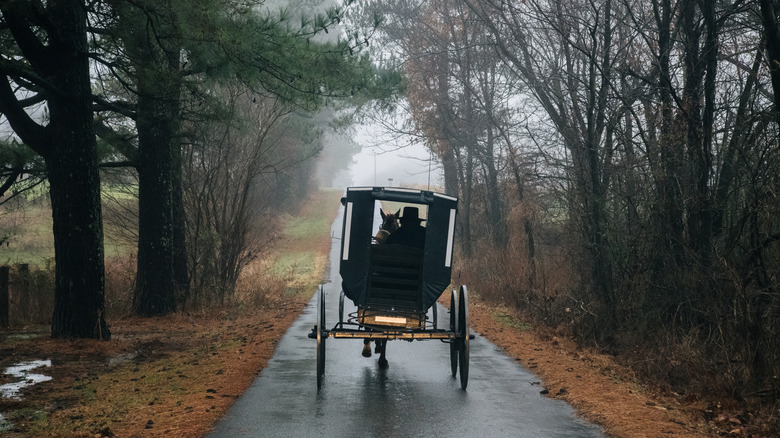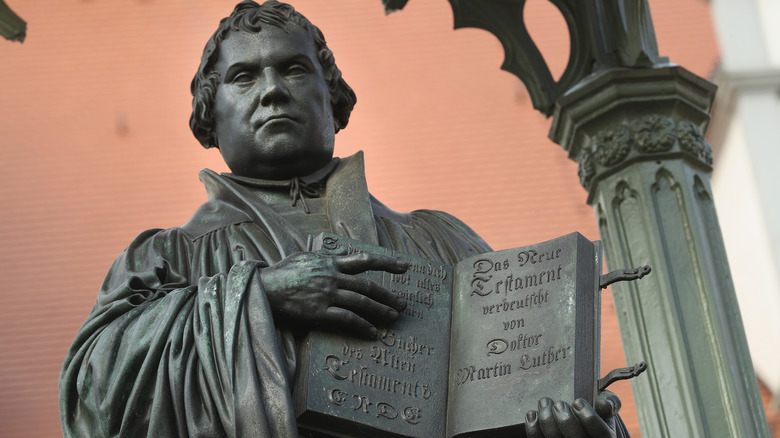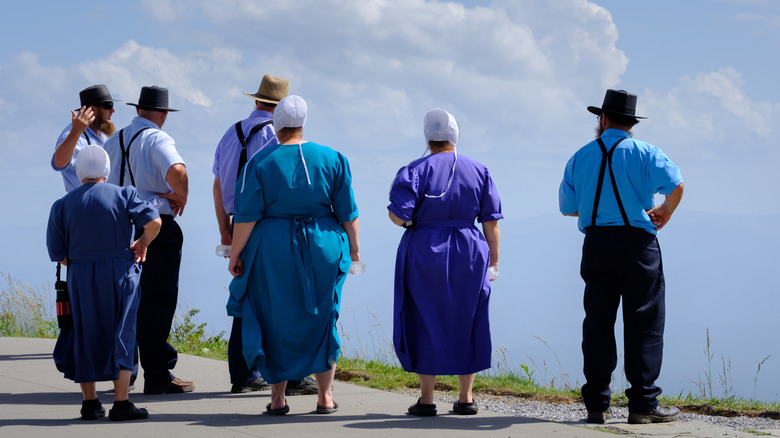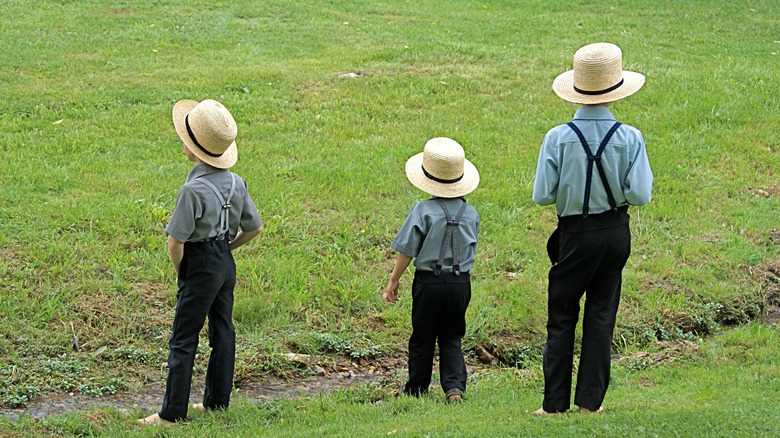The Biggest Differences Between The Amish And Mennonites
The Amish: chinstrap beard dudes and bonneted women in long skirts who live in self-contained communities and shun technology. Mennonites: chinstrap beard dudes and bonneted women in long skirts who live in self-contained communities and shun technology, but sometimes also drive black cars. Mystery solved? Not quite. But if you ask any person on the street for a brief description of either the Amish or Mennonites, you might get an explanation as comically simple as that. And if you live near Lancaster, Pennsylvania, you might add of the Amish: those guys who own ultra-boutique furniture stores that will make you wonder if Ikea is actually in the trash-selling business.
But enough about Ikea's shoddy craftsmanship. You'd be forgiven for confusing the Amish and the Mennonites at a glance — the two peoples are more similar than, say, Manhattanite epicureans and Tibetan monks. Both the Amish and Mennonites are Anabaptist in origins, a group of early Protestant Christians who arose following the Protestant Reformation's fracturing of the Catholic church in the early 1500s.
Missouri State University explains that one Anabaptist group followed Dutch preacher Menno Simmons (1496 to 1561) and became Mennonites, while another group went with Swiss preacher Jakob Ammann (1644 to 1712) and became the Amish. Both groups adopted a back-to-basics Christianity that encompassed all aspects of life. But while the Amish focused on staying isolated from the world, Mennonites turned their attention outward to missionary work and mingling with society at large, per Discover Lancaster.
The birth of Protestant Anabaptism
Come 1517 C.E., Augustinian monk and university lecturer Martin Luther had had enough of certain Catholic church doctrine, particularly non-Biblical practices like the selling of indulgences for money to bribe God into doling lesser punishments, as ThoughtCo outlines. And so, he took his list of grievances — dubbed his 95 Theses — and openly protested the church. He was excommunicated four years later in 1521, but not before fracturing Catholicism's dominance and spawning a host of Christian splinter groups, per History.
Anabaptists were one prominent branch of Protestantism in its early days. As Anabaptist Faith says, they looked to the Bible itself to separate Biblical precepts from the accretion of hundreds of years of Catholic doctrine, theology, rituals, etc. Of particular importance to them was a refutation of infant baptism, and a statement of belief that only adults were capable of making such a decision for themselves. In fact, "Anabaptist" in Greek means "rebaptizer." Anabaptists also espoused a simpler, pared-down vision of Christianity, focusing on a personal "obedient love–faith relationship" between a person and God. They also adopted a non-violent attitude towards those who antagonized them.
In a significant symbolic decision, the first Anabaptists met in 1525 in the house of one of their members, Felix Manz, to baptize each other, per Bruderhof. These early Anabaptist leaders yielded to subsequent generations of leaders, who themselves yielded multiple Anabaptist offshoots, and so forth. The Amish and Mennonites are two such offshoots.
Followers of Menno Simons
In the 500 years since early Protestant Reformation Anabaptists followed preacher Menno Simmons, Mennonites haven't exactly vanished. The Oklahoma Historical Society says that Mennonites faced persecution over the centuries, and fled around the globe. Now, the Mennonite World Conference reports over 2 million Mennonites spread around the world in 86 different countries. Most of them live on the African continent, and over two-thirds of Mennonites claim African, Asian, or Latin American heritage. There are 109 recognized national Mennonite churches worldwide. Pilgrim Ministry, meanwhile, has an interactive world map of 808 Mennonite congregations, with the densest cluster of small churches found in the United States. On that note, Mennonite Church USA has videos and pictures of very un-skirted and non-bearded Mennonites, a clear indication that Mennonite practices have continued to branch off and evolve into modernity.
That being said, there seems to be negligible discord or disharmony between various Mennonite communities. The Oklahoma Historical Society discusses differences between Mennonite groups, including wearing typical skirts-and-suspenders clothing or not, driving cars or not, going to university and getting jobs in the wider world like anyone else or not, and so forth. Ultimately, such differences remain incidental to central Mennonite tenets of Christian charity, outreach, and the same adult baptism that defined early Anabaptists. The Mennonite Central Committee (MCC) perfectly exemplifies Mennonite ideals and unity — it's the one and only worldwide, mutual Mennonite international disaster relief organization, one which supports impoverished, imprisoned, and other "vulnerable communities" around the globe.
Followers of Jakob Ammann
Now that the reader has a clearer understanding of Mennonites, the differences between them and the Amish should come across as far clearer. Despite being arguably the more well-known of the two Christian groups, the Amish are far less numerous than Mennonites. Their 367,000 or so members exist almost exclusively in the original place to where they fled religious persecution: the United States. Only about 6,000 Amish live in Canada, as Amish America says, with recent communities having cropped up in Argentina and Bolivia. On top of this, almost 45% of United States' Amish live in their top 10 most populous communities in Indiana, Ohio, Illinois, and Pennsylvania, also per Amish America. The largest of these communities unsurprisingly lives in Lancaster, Pennsylvania, which Amishview Inn & Suites says is the original location where the Amish settled.
By and large, the Amish stay separate from the wider world and take their traditions very seriously — including "shunning" rulebreakers, per Amish Baskets. But they do welcome visitors, as Discover Lancaster shows. No doubt owning to their community isolation, geographic concentration, and steadfast conservatism, the Amish tend to be more homogenous across communities. Amishview Inn & Suites mentions that particular Amish mainstays exist everywhere, like using horse-driven buggies, with choices limited to the color of the buggy. On her personal website, author Mary Schrockbooks — who grew up "Old Order Amish" — adds that some Amish communities have taken to using electricity if they want.
Isolation vs. integration
At this point, the reader can likely see the single biggest difference between the Amish and Mennonites, and how that main difference cascades into every other difference between the Amish and Mennonites: isolation vs. integration. The Amish remain only loosely tethered to the rest of humanity through things like selling homemade goods and tours of Amish farms. Mennonites, meanwhile — unless they're "Old Order Mennonites," as Learn Religions explains — could pass for any other person on the street, or any other 21st-century Christian. A progressively-minded Mennonite, for instance, holds onto core Christian values while doing things that the Amish would call "worldly," per Amish Baskets, like driving a car.
That's only certain Mennonites, however. This brings us to another key difference between them and the Amish: degree of differences in practices within each sect. All Amish communities are ultimately strict, and differences between them minor. Some Mennonites, per Christian History, are nearly as strict as the Amish and require specific haircuts and clothing, and have their own trappings that they consider "worldly," even zippers or belts — hence the suspenders. Other Mennonite groups "are among the most liberal churches" in the United States, as Christian History puts it, and even have gay preachers. A video from Mennonite Church USA shows singers on stage at a Mennonite service that wouldn't look out of place at any random, non-denominational guitar-and-drums Sunday song time.
Differently Christian and growing
Snyder's Furniture has a handy overview of further differences between the Amish and Mennonites, not including minor things like head coverings that are, frankly, too numerous and niggling to go over in this article. Ultimately, both the Amish and Mennonites are Christian groups, even though the Amish's Christianity can seem more deeply submerged beneath in-your-face conversation points like, "Hey, those guys drive buggies and are really awesome at carpentry."
Since both the Amish and Mennonites are fundamentally Christian, they have their own way of conducting services. The Amish host services in private in their own homes in strict adherence to the Anabaptist "obedient love–faith relationship" roots we mentioned, described on Anabaptist Faith. These services, interestingly enough, are not always conducted in English. Snyder's Furniture says that Pennsylvania Amish might conduct services in Pennsylvania Dutch, for example. Mennonites, in complete contrast, hold what you might consider typical, public Protestant church services, but with the aforementioned wide Mennonite range of differences. Also, Mennonites conduct services in native languages, like English.
As a final note, it's the Amish who've seen a population boom within the past 10 years. In 2012, Bloomberg reported 251,000 Amish in North America, a number which in 2022 jumped to about 367,000. While folks might be inclined to think that modernity has driven people into the Amish's rustic arms, the population jump is due to communities staying self-contained while not using birth control. "Some people would claim 90 percent of daughters and sons get baptized Amish and start families," sociology professor Joseph Donnermeyer told Bloomberg.





